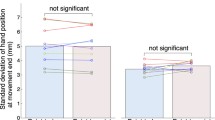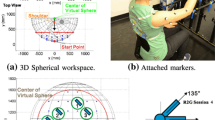Abstract
The human arm is kinematically redundant, which may allow flexibility in the execution of reaching movements. We have compared reaching movements with and without kinematic redundancy to unpredictable double-step targets. Subjects sat in front of a digitising tablet and were able to view an arc of four targets reflected in the mirror as virtual images in the plane of the tablet. They were instructed to move, from a central starting point, in as straight a line as possible to a target. In one-third of trials, the target light switched to one of its neighbours during the movement. Subjects made 60 movements using shoulder, elbow and wrist and then another 60 movements in which only shoulder and elbow movement were allowed. By restraining the wrist, the limb was made non-redundant. The path length was calculated for each movement. In single-step trials, there was no significant difference between path lengths performed with and without wrist restraint. As expected there was a significant increase in path length during double-step trials. Moreover this increase was significantly greater when the wrist was restrained. The variability across both single- and double-step movements was significantly less while the wrist was restrained. Importantly the performance time of the movements did not alter significantly for single-step, double-step or restrained movements. These results suggest that the nervous system exploits the intrinsic redundancy of the limb when controlling voluntary movements and is therefore more effective at reprogramming movements to double-step targets.
Similar content being viewed by others
Author information
Authors and Affiliations
Additional information
Received: 24 March 1997 / Accepted: 7 July 1997
Rights and permissions
About this article
Cite this article
Robertson, E., Miall, R. Multi-joint limbs permit a flexible response to unpredictable events. Exp Brain Res 117, 148–152 (1997). https://doi.org/10.1007/s002210050208
Issue Date:
DOI: https://doi.org/10.1007/s002210050208




